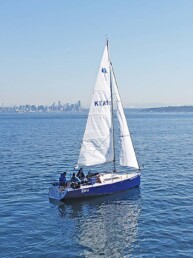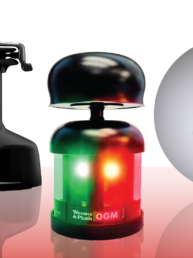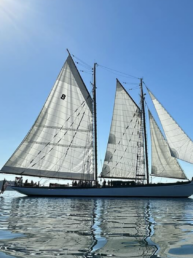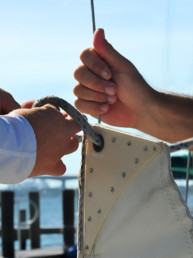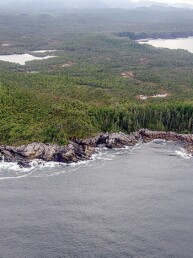Pacific Northwest-based cruisers Becca and John sailed away on their Valiant 40 Halcyon and shared their great stories with 48° North for several years. In the time since, they’ve returned to our local waters, moved aboard a different boat, and welcomed two new crew members, one canine and the other a tiny human. Here’s a fabulously fun article from their travels, which originally appeared in the December 2016 issue of 48° North.
Anyone who owns a boat will likely agree with me: boat projects are absurd. Various boat owners quantify this absurdity differently – some base it solely on price, others use their curse word count as a measure. For me, the absurdity of a project is based on the amount of time, resources, and bruises it demands as weighed against the complexity of the project. The more time and energy it takes to complete a disproportionately simple task, the more absurd it seems.
We end up doing a lot of absurd boat projects around here, from running a new antenna wire (five hours, half a roll of tape, and three new bruises) to replacing a door latch (two hours, three different types of latches, one serious bruise). But we recently set a new standard – in fact, I think we broke the scale – for project absurdity.
The new standard? Three days, four trips to the hardware store, eight broken drill bits, seven bruises, five metal splinters, three dozen grey hairs and two pissed off humans. The project?
We replaced a shock chord. That’s right: we replaced a shock chord. That’s right: it took three days.

It all started when we were sailing towards Golden Gate Bridge under our full color spinnaker (the “whomper”) and I noticed the bungee chord side of the bridle between the spinnaker pole and the topping lift was frayed almost all the way through at full tension. I made a mental note to add it to the (rapidly lengthening) project list for our stopover in San Francisco.
When the project came up to the top of the list, I spent a while jiggling the bungee with my ear to the pole, trying to discern where it ended, to no avail. So I made my best guess and took a drill to the stainless steel rivets at the center connection, where two sections of the pole join. It took two of us with some line engineering and a winch to separate the sections a few inches, but we couldn’t slide the two apart; the wire connecting the pull chords to the jaws were too short to allow any extension in the pole. But I could peer through the crack and see that there was no bungee chord end in sight. In fact – the chord was doubled, which means I most certainly did not buy enough replacement chord!
I cleaned up the metal rivet slivers and called it a day.
The next morning I stared at the spinnaker pole for a good 30 minutes before just closing my eyes and pointing to an end with a 50/50 shot to find the shock chord terminus. Another round of rivet drilling and I pulled off the mast end of the pole to find… a doubled up shock chord with no end.
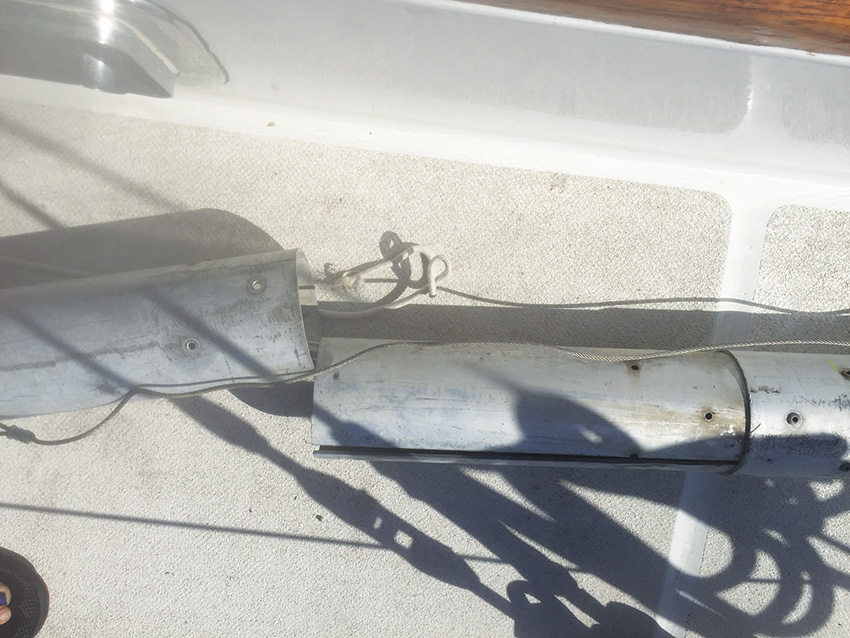
There are only three places where it is possible to disassemble our spinnaker pole. In case you’re not keeping track, I’ve now disassembled two of them. I have a stare-down with the jaws end of the pole. This side is not attached with rivets, but with flathead stainless steel bolts. Huge bolts that have had decades to sit in salt water, gradually fusing with the aluminum around them to form disfigured mounds of indistinguishable metal. This was war. I poured on the better part of a bottle of PB Blaster and came back a few hours later armed with a torch, a mallet, an impact driver, and a stiff drink.
I’ll save you the gory details, but have to confess the spinnaker pole was winning. I was down four impact bits, I was bleeding, and my drink was empty. Not a single bolt had budged. I called for backup. John headed into battle while I licked my wounds. But he lost a few more drill bits and gained a few wounds without making any progress. We retreated for the night.
As with many wars drawn out too far, we had long since forgotten why we were battling the spinnaker pole in the first place, the shock chord far from our minds. We just knew those bolts had to come out. Enough damage had been done now; we had to finish the job.
Morning of day three, John awakens with a new tactic that came to him in a dream. I did not make that up; John came up with a new method for removing the corroded bolts while he was sleeping. Using a zap strap, a heavy-duty screwdriver, a crescent wrench and a lot of arm strength, he was able to rip out those bolts, recovering the ground we had previously lost and claiming a victory at last.
I did a celebration dance and stepped on some metal shards, quickly pulled out of my revelry to survey the damage. Most of the tools we own littered the decks. Piles of metal shrapnel threatened our every step. The spinnaker pole lay there in four pieces, broken and dejected. Out of the corner of my eye I caught a neatly coiled shock chord, brand new and likely much too long, and the full absurdity of this project hit me hard.
It took me no longer than twelve minutes to run the new shock chord. Twelve minutes.
Then a new battle began. We had to buy a rivet gun; then go back for bigger rivets. Nobody in Sausalito carries bolts that wide. It took all the grease we had to hammer the two sections of pole back together. We snapped the tap in half trying to rethread one of the more disfigured bolt holes. It was the last one, so we called it finished; 4 bolts are plenty.
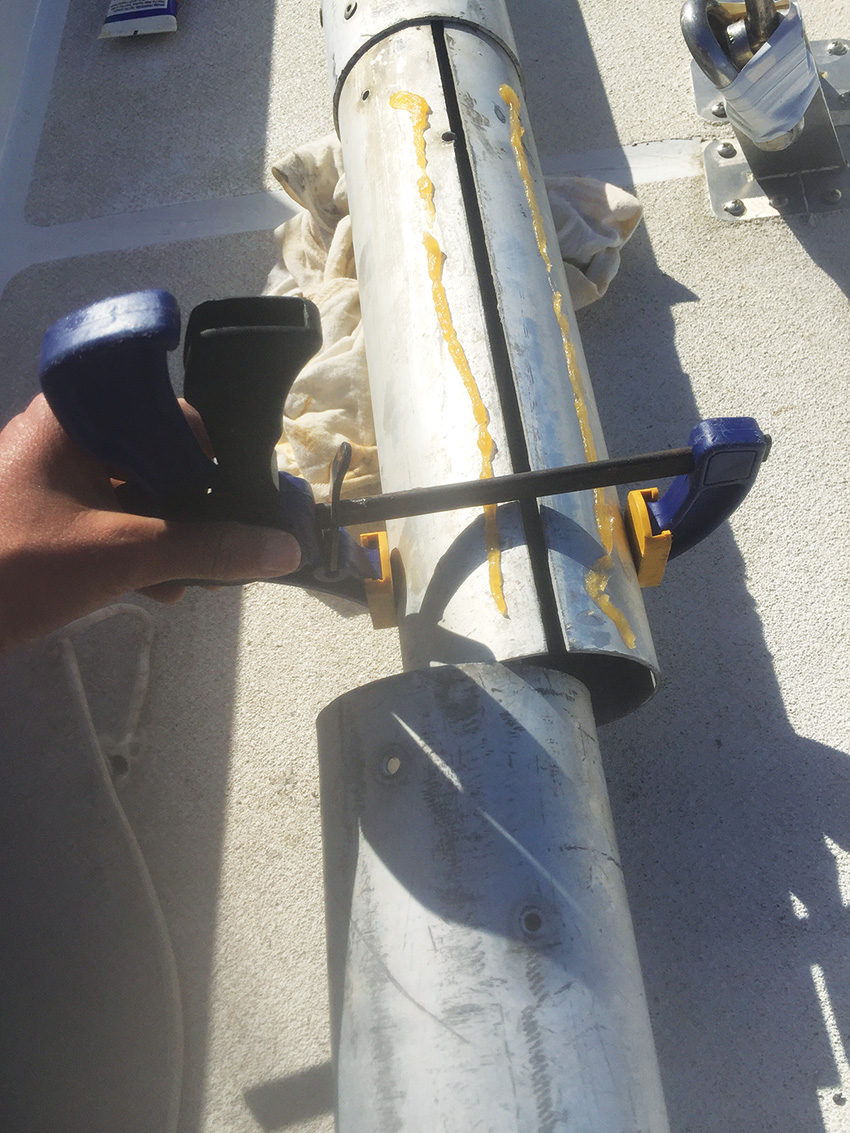
Perhaps the most challenging part of the boat project that careens off the Scale of Absurdity is that after all that, the pole doesn’t look any different. A few shiny rivets, a shock chord that is still white, many more dings and scratches, but basically the same. However, I can say with certainty I will never look at it the same again. That spinnaker pole commands a whole new level of deference. And that shock chord – I look at that bungee with equal parts contempt (for leading me into that mess) and protection (to ensure I never have to do it again). The best part, of course, is marking another project off the list.
Their adventures are also chronicled at halcyonwandering.com
Becca Guillote
Becca Guillote and her husband, John, are young Seattle-based cruisers exploring the world aboard their Valiant 40, Halcyon. After a massive 2019 that included their first Pacific Crossing, they temporarily decommissioned Halcyon in the Marquesas to pursue some short term opportunities to refill the cruising kitty including work on the Arctic Ocean R/V Sikuliaq (www.iceinmotion.com). You can follow their adventures at http://halcyonwandering.com/

